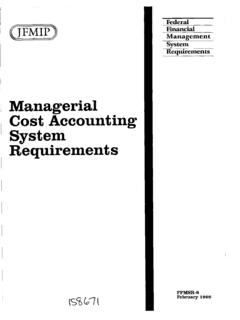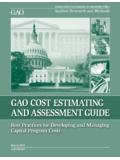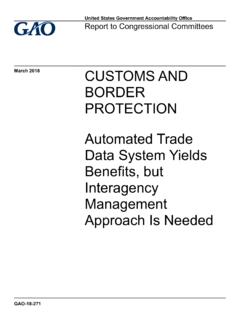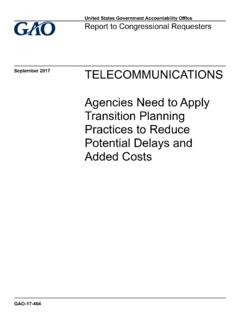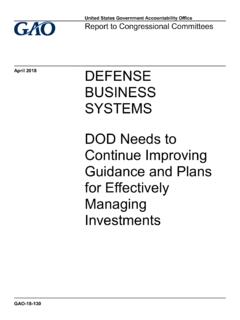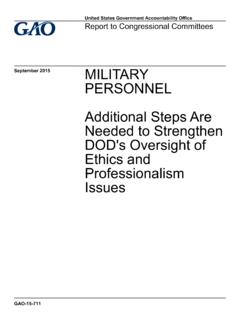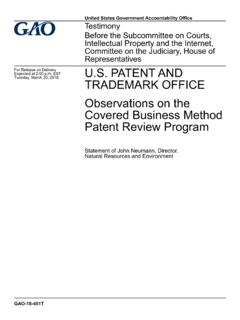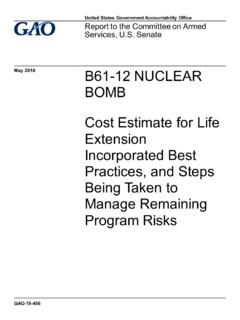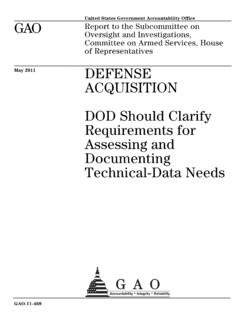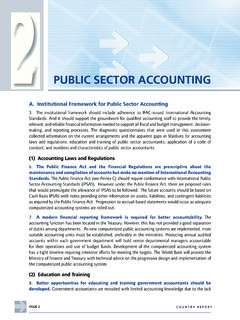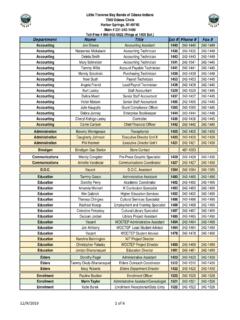Transcription of GAO-02-447G Executive Guide: Best Practices in Achieving ...
1 United States General accounting Office GAO March 2002 Executive GUIDE Best Practices in Achieving consistent , accurate physical Counts of inventory and Related Property a GAO-02-447G Preface Creating an effective and cost-efficient government has long been a public expectation. Achieving this goal will require federal agencies to produce useful, reliable, and timely information that can be used daily by the Congress, federal managers, and other decisionmakers. inventory is one of the major areas in the federal government where useful, reliable, and prompt data are still generally not ava ilable.
2 To provide a framework and guide that federal managers can use to improve the accuracy and reliability of the government s inventory and related property data, we studied the inventory count processes and procedures of seven leading-edge private sector companies to identify the key factors and Practices they use to achieve accurate and reliable physical counts. physical counts of inventory are only one aspect of inventory control that contribute to accurate and reliable inventory records. This Executive Guide, while intended to assist federal agenc ies in Achieving the objectives of the Chief Financial Officers (CFO) Act of 1990 and subsequent related legislation, is also applicable to any governmental and nongovernmental entity holding inventory or property and equipment.
3 This Executive Guide describes the fundamental Practices and procedures used in the private sector to achieve consistent and accurate physical counts. It summarizes the fundamental principles that have been successfully implemented by companies recognized for their outstanding record of inventory Also, it explains and describes leading Practices from which the federal government may be able to draw lessons and ideas. This guide applies to most forms of federal inventory , but certain of the discussed Practices may not be applicable to various types of bulk, natural resource, and nonturning inventories, such as the Department of Energy s strategic petroleum reserve.
4 Many of the concepts and controls for conducting physical counts discussed in this guide could also be applied to property, plant, and equipment, an area in which many federal agencies also face data reliability challenges. This guide was prepared under the direction of Gregory D. Kutz, Director, Financial Management and Assurance. Other GAO contacts and key contributors are listed in appendix VI. Please address any questions or comments to me at (202) 512-2600, or Paul D. Kinney, Assistant Director, by phone, e-mail, or regular mail at the following: 1 See Appendix II, Objectives, Scope, and Methodology.
5 1 GAO-02-447G Best Practices in inventory Counts Mail: Paul D. Kinney, Assistant Director General accounting Office 1244 Speer Blvd., Suite 800 Denver, CO 80204 Phone: (303) 572-7388 Email: Jeffrey C. Steinhoff Managing Director, Financial Management and Assurance 2 GAO-02-447G Best Practices in inventory Counts Contents Background 5 Identification and Characteristics of Leading-edge Companies 8 Key Factors in Achieving consistent and accurate Counts of 10 physical Inventories Key Factor 1: Establish Accountability Performance Goals Level of Accountability Strategies to Consider Key Factor 2: Establish Written Policies Strategies to Consider Key Factor 3: Select an Approach Strategies to Consider Key Factor 4.
6 Determine Frequency of Counts Frequency of Counts Method of Selecting Items Strategies to Consider Key Factor 5: Maintain Segregation of Duties physical Custody of Assets Transaction Processing and Recording Approval of Transactions Strategies to Consider Key Factor 6: Enlist Knowledgeable Staff Counters Are Knowledgeable about the inventory Items Counters Are Knowledgeable about the count Process count Personnel Are Well-Trained Strategies to Consider Key Factor 7: Provide Adequate Supervision Strategies to Consider Key Factor 8: Perform Blind Counts Strategies to Consider Key Factor 9: Ensure Completeness of the count Cutoff Procedures Preinventory Activities Control Methods for count Completion Strategies to Consider 12 16 20 24 28 32 36 39 42 3 GAO-02-447G Best Practices in inventory Counts Key Factor 10: Execute physical count Communicate Information to the Counter Verify Item Data and Quantity Capture and Compare the count Perform Requisite Number of Counts Complete Counts in a Timely Manner Strategies to Consider Key Factor 11: Perform Research Required Research Timely Research Approval and Referral of Adjustments Strategies to Consider Key Factor 12.
7 Evaluate count Results Performance Measures Communication of Results Modification of Policies and Procedures Strategies to Consider 47 51 55 Appendixes Appendix I: Implementation Checklist 60 Appendix II: Objectives, Scope, and Methodology 71 Appendix III: Bibliography 73 Appendix IV: Other Related Publications 74 Appendix V: Acknowledgment of Best Practice Participants 75 Appendix VI: GAO Contacts and Staff Acknowledgments 76 4 GAO-02-447G Best Practices in inventory Counts Background accurate and reliable data are essential to an efficient and effective operating environment in the private sector as well as in the federal government.
8 inventory represents a significant portion of assets in the federal government and private sector. Therefore, managers and other decisionmakers need to know how much inventory there is and where it is located in order to make effective budgeting, operating, and financial decisions and to create a government that works better and costs less. In the 1990s, the Congress passed the Chief Financial Officers Act of 1990 and subsequent related legislation, the Government Management Reform Act of 1994, the Government Performance and Results Act of 1993, and the Federal Financial Management Improvement Act of 1996.
9 The intent of these acts is to (1) improve financial management, (2) promote accountability and reduce costs, and (3) emphasize results-oriented management. For the government s major departments and agencies, these laws (1) established chief financial officer positions, (2) required annual audited financial statements, and (3) set expectations for agencies to develop and deploy modern financial management systems, produce sound cost and operating performance information, and design results-oriented reports on the government s financial position by integrating budget, accounting , and program information.
10 Federal departments and agencies work hard to address the requirements of these laws but are challenged to provide useful, reliable, and timely inventory data, which is still not ava ilable for daily management needs. Managing the acquisition, production, storage, and distribution of inventory is critical to controlling cost, operational efficiency, and mission readiness. Proper inventory accountability requires that detailed records of produced or acquired inventory be maintained, and that this inventory be properly reported in the entity s financial management records and reports. For example, detailed asset records are necessary to help provide for the physical accountability of inventory and the efficiency and effectiveness of operations.
